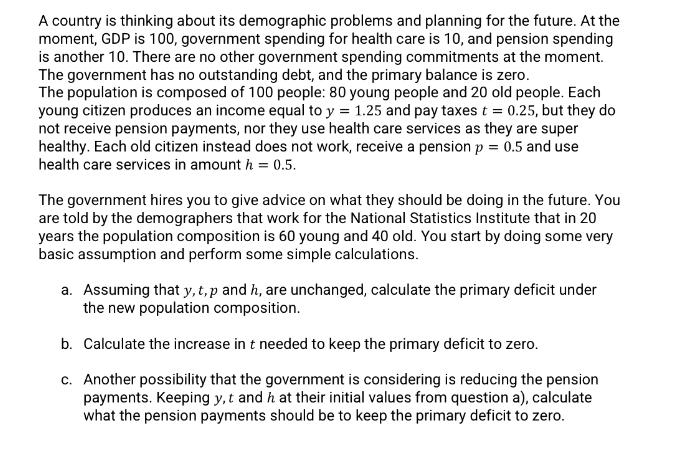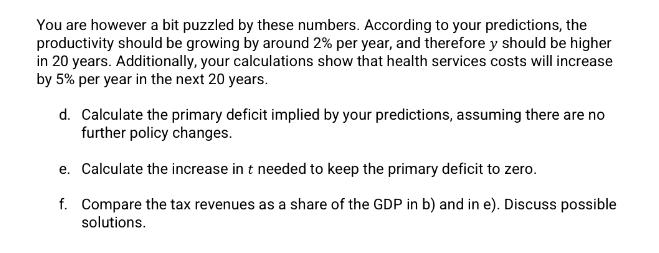Answered step by step
Verified Expert Solution
Question
1 Approved Answer
A country is thinking about its demographic problems and planning for the future. At the moment, GDP is 100, government spending for health care


A country is thinking about its demographic problems and planning for the future. At the moment, GDP is 100, government spending for health care is 10, and pension spending is another 10. There are no other government spending commitments at the moment. The government has no outstanding debt, and the primary balance is zero. The population is composed of 100 people: 80 young people and 20 old people. Each young citizen produces an income equal to y = 1.25 and pay taxes t = 0.25, but they do not receive pension payments, nor they use health care services as they are super healthy. Each old citizen instead does not work, receive a pension p = 0.5 and use health care services in amount h = 0.5. The government hires you to give advice on what they should be doing in the future. You are told by the demographers that work for the National Statistics Institute that in 20 years the population composition is 60 young and 40 old. You start by doing some very basic assumption and perform some simple calculations. a. Assuming that y, t,p and h, are unchanged, calculate the primary deficit under the new population composition. b. Calculate the increase in t needed to keep the primary deficit to zero. c. Another possibility that the government is considering is reducing the pension payments. Keeping y, t and h at their initial values from question a), calculate what the pension payments should be to keep the primary deficit to zero. You are however a bit puzzled by these numbers. According to your predictions, the productivity should be growing by around 2% per year, and therefore y should be higher in 20 years. Additionally, your calculations show that health services costs will increase by 5% per year in the next 20 years. d. Calculate the primary deficit implied by your predictions, assuming there are no further policy changes. e. Calculate the increase in t needed to keep the primary deficit to zero. f. Compare the tax revenues as a share of the GDP in b) and in e). Discuss possible solutions.
Step by Step Solution
There are 3 Steps involved in it
Step: 1
Lets go through each part of the problem step by step a Calculate the primary deficit under the new population composition Initially there are 80 youn...
Get Instant Access to Expert-Tailored Solutions
See step-by-step solutions with expert insights and AI powered tools for academic success
Step: 2

Step: 3

Ace Your Homework with AI
Get the answers you need in no time with our AI-driven, step-by-step assistance
Get Started


